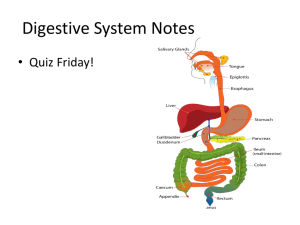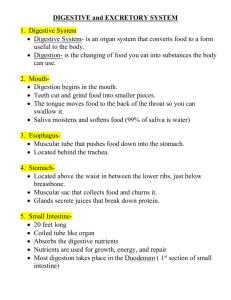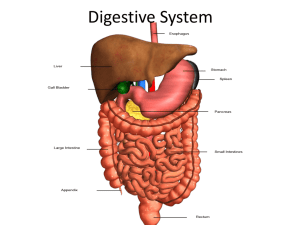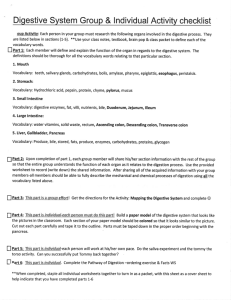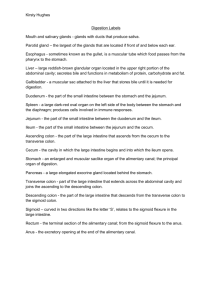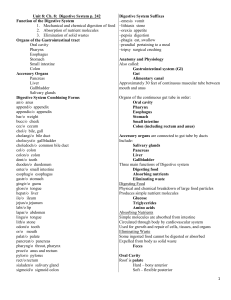Digestive System
advertisement
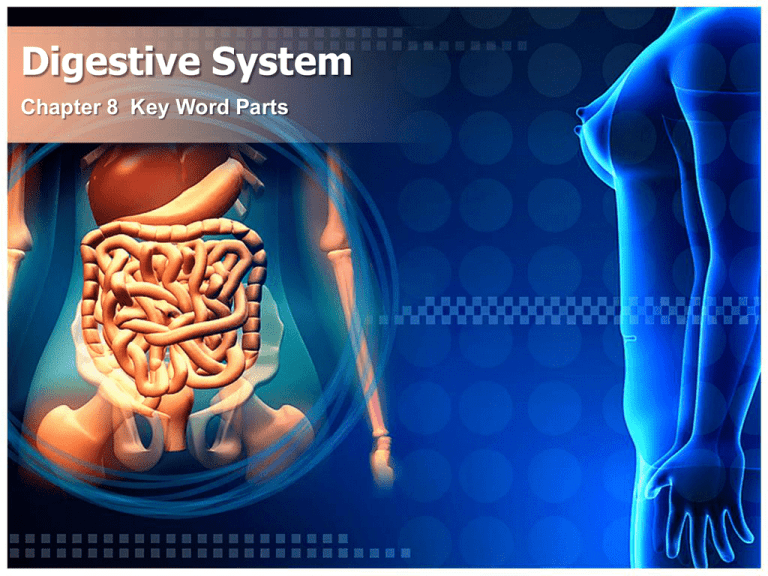
Digestive System Chapter 8 Key Word Parts An/o • Ring • Having to do with the Anus • Anus – The lower opening of the digestive tract. – The flow of waste through the anus is controlled by the two anal sphincter muscles. Cec/o • Having to do with the cecum • The cecum is a pouch that lies on the right side of the abdomen. It extends from the end of the ileum to the beginning of the colon. • The appendix hangs from the lower portion of the cecum. Chol/e • Having to do with bile or • Gall • Bile – A digestive juice containing enzymes that break down fat. – The term biliary, as in the biliary system, means pertaining to bile. – Is released into the small intestine as needed. Cholecyst/o • Having to do with the gallbladder • The gallbladder is a pear-shaped sac located under the liver. It stores and concentrates the bile for later use. • Cholecystic mean pertaining to the gallbladder. Col/o, colon/o • Pertaining to the Colon • or Large intestine • The large intestine extends from the end of the small intestine to the anus. Waste products of digestion are processed in the large intestine and then excreted through the anus. • The colon is subdivided into four parts – – – – Ascending colon Transverse colon Descending colon Sigmoid colon Enter/o • Having to do with the small intestine • The small intestine extends from the pyloric sphincter to the first part of the large intestine. • It is here that the nutrients from food are absorbed into the bloodstream • A coiled organ that is up to 20 feet in length • Consists of three parts – Duodenum – Jejunum – Ileum Esophag/o • Meaning esophagus • Also known as the gullet • A collapsible tube that leads from the pharynx to the stomach Gastr/o • Having to do with the stomach or belly • The stomach breaks down food and mixes it with digestive juices • A saclike organ composed of the – Fundus • Upper, rounded part – Body • Main portion – Antrum • Lower part Hepat/o • Meaning liver • The liver is located in the right upper quadrant (RUQ) of the abdomen and has several important functions – Removes excess glucose from the blood stream and stores it as glycogen – Destroys old erythrocytes, removes poisons from the blood, and manufactures some blood proteins – Secretes bile but does not store it • Bilirubin is a pigment produced from the destruction of hemoglobin. It is released by the liver in bile. Excess bilirubin in the blood is associated with jaundice. Jaundice -lithiasis • Meaning the presence of stones • Cholelithiasis – The presence of gallstones in the gallbladder or bile ducts • The gallstone itself is known as a biliary calculus, it is a hard deposit Pancreat/o • • • • Meaning the pancreas The pancreas is a feather-shaped organ Located posterior to the stomach Has important roles in both the digestive and endocrine systems -pepsia • Meaning to digest or digestion • Dyspepsia – Indigestion – And impairment of digestion Proct/o • Meaning anus or rectum • Proctologist – A doctor who specializes in disorders of the colon, rectum, and anus Rect/o • Meaning rectum or straight • The rectum is the last division of the large intestine • Ends at the anus Sigmoid/o • Refers to the sigmoid colon • The sigmoid colon is an S-shaped structure that continues from the descending colon above and joins with the rectum below Or/o • Meaning the mouth or oral cavity • Major structures of the oral cavity are – Lips – Hard and soft palates • Forms the roof of the mouth • Hard palate forms the bony anterior portion • Soft palate forms the flexible posterior portion – Salivary glands – Tongue – Teeth – Periodontium • The bone and soft tissues that surround and support the teeth Pharyng/o • Refers to the throat or pharynx Digestion • The process by which complex foods are broken down into nutrients in a form the body can use • Enzymes – Responsible for the chemical changes that break foods down into simpler forms of nutrients for use by the body • Nutrients – A substance, usually from food, that is necessary for normal functioning of the body Metabolism • The sum of anabolism and catabolism • All of the processes involved in the body’s use of nutrients • Anabolism – The building up of body cells and substances from nutrients • Catabolism – The opposite of anabolism – The breaking down of body cells or substances, releasing energy and carbon dioxide Miscellaneous • • • • • Mastication – Chewing – http://www.metacafe.com/watch/anq_g4btmJthY2t/miss_congeniality_2000_victors_consulting _history/ Peristalsis – A series of wavelike contractions of the smooth muscles in a single direction Chyme – The semifluid mass of partly digested food that passes from the stomach into the small intestine Flatulence or flatus – a fart Borborygmus – The rumbling noise caused by the movement of gas in the intestine Digestive System Medical Specialties • • • • • • Dentist Gastroenterologist Internist Orthodontist Periodontist Proctologist
